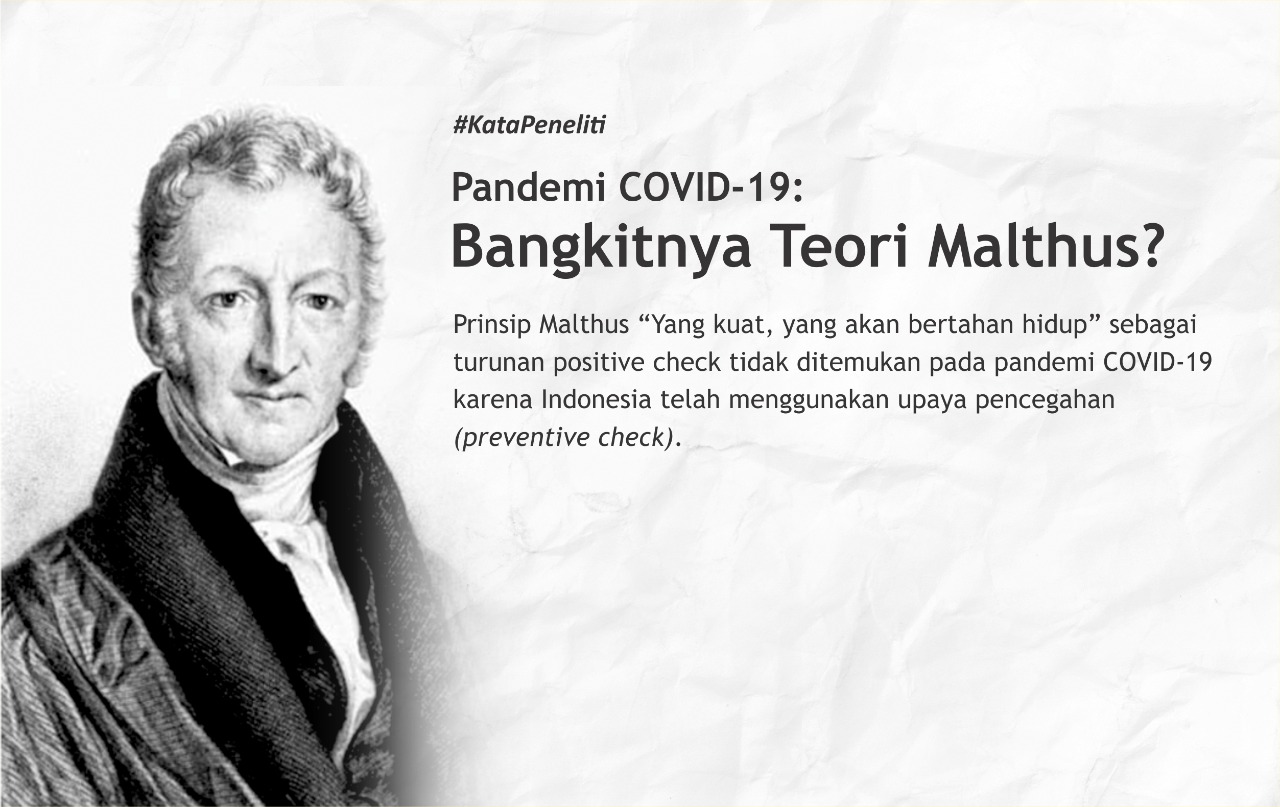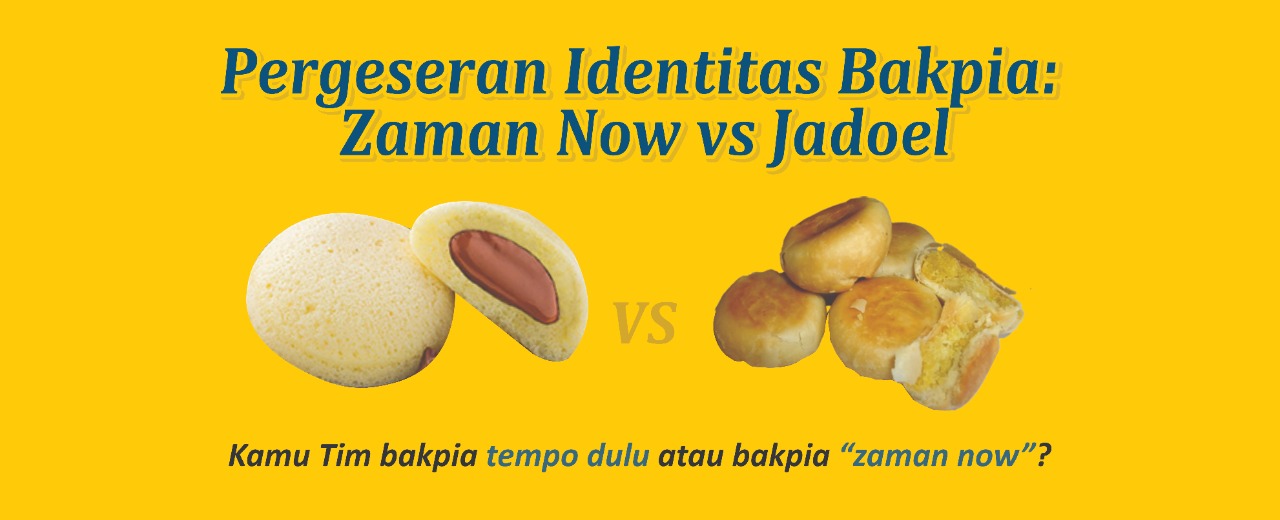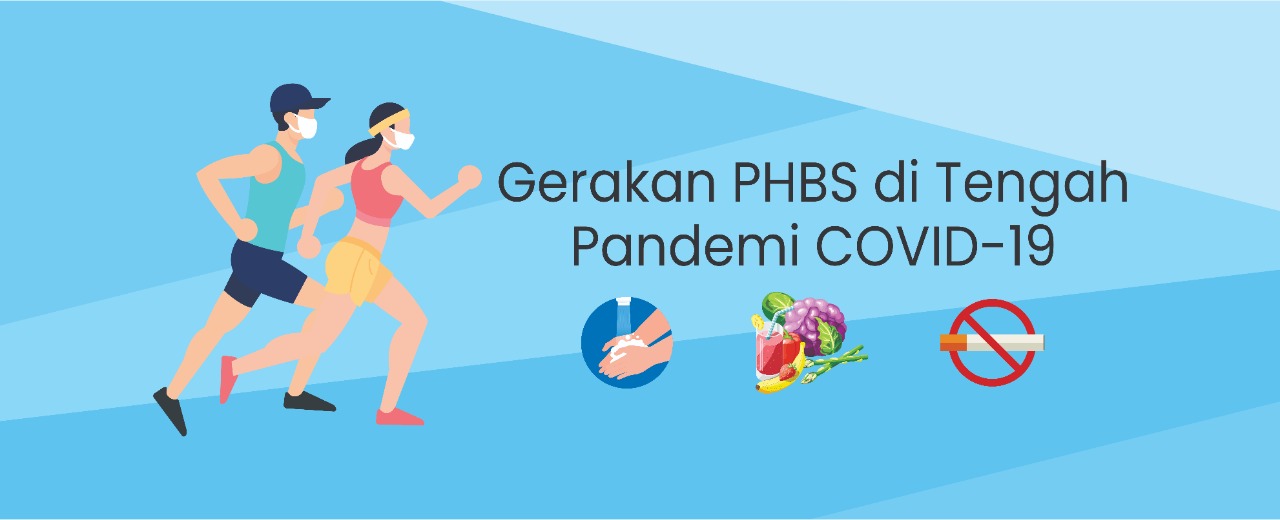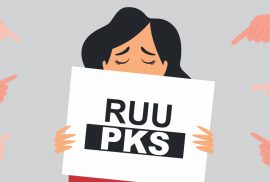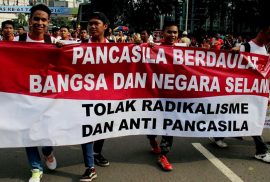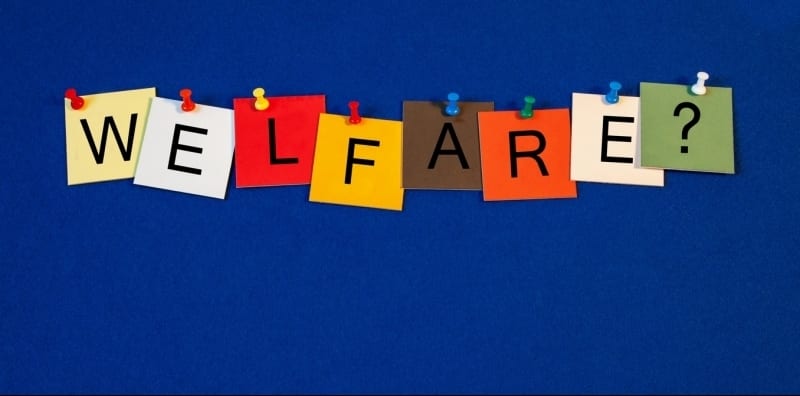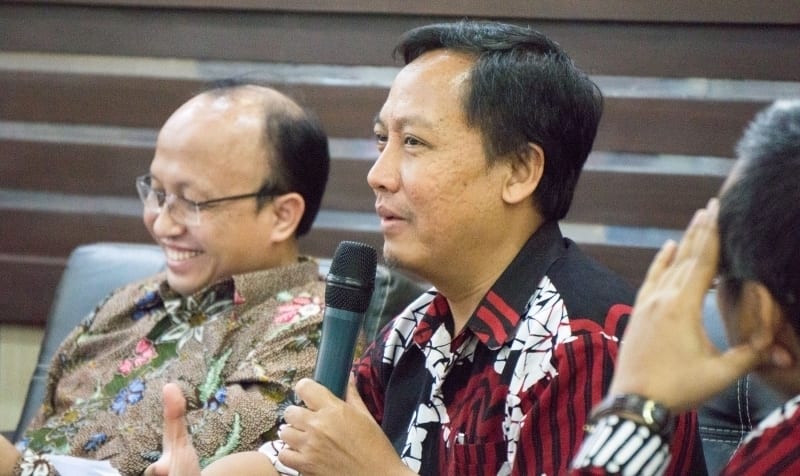CPPS UGM – Population sector is often closely related to public policy terminology.
Essay & Opinion
Yogyakarta, CPPS UGM – The world has not currently become free from the COVID-19 pandemic, even the cases are still showing an increase in some countries, including Indonesia. The real concern of the spike in cases is the limited of medical services due to the limited capacity of medical facilities and resources in treating patients. If this happens, the unhandled problem of high mortality rate due to COVID-19 and other diseases will then become unavoidable. Until the end of August 2021, the mortality rate of COVID-19 was 4.51 million. The COVID-19 cases in Indonesia have reached 4.08 million people with the mortality rate of 132,000 people.
The high mortality rate during a pandemic will affect the number and structure of the world’s population. At the beginning of the pandemic, for instance, many deaths due to COVID-19 were found in elderly and thus, it may change the composition of population in an area. The official record of changes in population structure due to the COVID-19 pandemic has not been studied in detail and the data has not been released as well due to the high amount of energy and resources being absorbed to deal with COVID-19. The current deaths due to COVID-19 no longer occur in certain age groups, but in almost all age groups. Therefore, the public is increasingly anxious and worried, especially regarding the high mortality rate which will reduce the population.
This situation reminds us of the old theory put forward by Thomas Malthus. At the end of the 17th century (1798), Malthus wrote his opinion in a provocative article entitled An essay in the principle of population as it affects the future improvement of society. He was concerned about the imbalance between developing population growth and food availability. He said that population growth following a geometric series (e.g., from 2 to 4, from 4 to 8, from 8 to 16 and so on) will not be supported by the ability to produce food whose growth follows an arithmetical series (e.g., from 1 to 2, 3, 4, etc.). He then analyzed that as the population grew, the competition among individuals was getting tougher. This situation will be exacerbated by the presence of disastrous factors, such as seasonal disease, epidemics, and catastrophic outbreaks that can wipe out the population. He suggested two things to balance the rate of population growth with food availability, i.e., preventive check and positive check. The former is an effort made to keep population growth under control, such as avoiding marriage and limiting the number of births. The latter is one of the ways for controlling population growth through extreme means, such as war, disease and epidemics, poverty, and famine.
Regarding the COVID-19 pandemic and the deaths, cautious actions are needed to interpret the pandemic as a positive check. Moreover, governments in various countries have made preventive check. In Indonesia, the government has taken precautions to suppress the spread of COVID-19. Since being declared a pandemic by the head of state in March 2020, the government has implemented a large-scale social restriction (known as Pembatasan Sosial Berskala Besar/PSBB) policy. The policy is the basis for limiting public social activities in public spaces, such as education and some jobs that are performed online. In the mode of transportation, restrictions are made in terms of the passenger capacity and the intensity of its operation, while in places of worship, the policy is applied by not holding worship activities. The restrictions also operate in strategic sectors, such as health, economy and food, fuel oil and gas, and other basic needs. It is still in effect today by concerning the cases of COVID-19 that occurred in village and sub-district units. If no cases of COVID-19 are found in villages and sub-districts, then the activities in public spaces can be held. On the other hand, if thee COVID-19 cases are found, the activities will be restricted. In line with the restrictions on social activities, the government has taken other strategic steps in the form of preparing COVID-19 emergency hospitals, isolation places for COVID-19 sufferers, establishment of shelters, and COVID-19 detection tests. In terms of nomenclature and implementation, the restrictions are continuously updated following the developments of COVID-19 in the community. Therefore, there is no omission for the spread of COVID-19. The government has made preventive check so that the morbidity and mortality rate due to COVID-19 can be suppressed, and thus, natural factors and mechanisms that may work to achieve balance do not work alone. This gives rise to the principle of “Only the strong will survive” as a positive check derivative is not found.
Positive check, as what Malthus reasoned, is the operation of variables that affect population growth and are not controlled. This means that there is an impression of neglect until an evolution is created which is marked by the survival of a strong population, while the population that loses competition will become extinct. The ongoing pandemic cannot necessarily be said to be the “rise of Malthus” to achieve balance because efforts have been made to reduce the impact of deaths from the pandemic. A lockdown has been applied to limit the movement of people to suppress the spread of the COVID-19 virus. There are efforts to provide vaccines to create herd immunity and the establishment of emergency hospitals to deal with COVID-19. If such preventive efforts had not been made, the COVID-19 might have spread more massively and resulted in greater numbers of deaths. Finally, Malthusian theory which states that to get a balance between population and food availability can be reached through a positive check is not found in the COVID-19 pandemic.
References
Malthus. 1798. An Essay in the principle of population as it affects the future improvement of society. London. (http://www.ac.wwu.edu/~stephan/malthus/malthus.0.html; November 10, 2004)
A. Mukhopadhyay, Malthus. [2003]. Population Theory. An Irony in the Annals of Science, Breakthrough, Vol. 10, No. 3
*Sumini, S.Si., M.Si. | Researcher at CPPS UGM | Language translator: Rinta Alvionita | Illustration: Affen Irhandi/CPPS UGM
Yogyakarta – Apart from being popular with culture and education center, Yogyakarta is a province that is also known for its abundant natural and culinary. Therefore, it is not surprising that this area is one of the most visited tourist destinations, both domestic and foreign tourists, every year. The Department of Tourism of Yogyakarta noted that, before the COVID-19 pandemic in 2019, the growth of tourist arrivals to Yogyakarta increased by 15.15% from the previous year.
Yogyakarta, with its culinary, has one of the most identical food souvenirs favored by tourists, namely Bakpia. Most of the tourists buy the Bakpia while they are going to come home. Bakpia is sweet bean-filled moon cake-like pastry that is coated with flour and shaped, then baked. Based on its history, Bakpia is a form of acculturation between Chinese and Yogyakarta culture.
In the 1940s, Bakpia was brought by Chinese immigrants who lived in the Pathuk area (Ameer, in Nihayati, 2020). In China, Bakpia is similar to pork-filled cakes. However, since the majority of Indonesians are Muslim and forbidden to eat pork, the Bakpia filling was then replaced with sweet green beans (Eriyanto, 2018). The Chinese-Indonesian families usually enjoy the Bakpia as a family snack (Nihayati, 2020). In 1930, however, there was an economic depression in the Dutch East Indies (now: Indonesia), thus some of these Chinese-Indonesian families sold the Bakpia to increase their income (Nihayati, 2020). As time goes by, many home industries in the 1980’s started to sell Bakpia. This is indicated by the number of Bakpia that are sold under the brand according to the house number of the producer. 1992 was the peak of the rapid development of the Bakpia industry and began to be popular as a typical food souvenir of Yogyakarta.
Bakpia has many flavors over time. The flavors of classic Bakpia (known as Bakpia Jadoel) are green beans and red beans. Meanwhile, the modern Bakpia has more flavors, such as chocolate, cheese, nuts, green tea, coffee, fruits, etc. Currently, there is one modern Bakpia brand named Bakpia Tugu which is very different from that of the Bakpia Jadoel. The modern one is a steamed-mini bun like Bakpia with a filling of green beans, chocolate, cheese, chocolate brownies, and so on, that texture can melt in the mouth. Today’s young people call the Bakpia Tugu “Bakpia Zaman Now”. The Bakpia Zaman Now is no less in demand than the Bakpia Jadoel. Moreover, in one of its stores located in Jalan Kaliurang, there is often a long line of the buyers coming from outside the city who just want to enjoy it. The people carrying grocery bags from the Bakpia Tugu is easy to see at Yogyakarta airports and stations. The Bakpia Tugu has opened six branch stores within three years. It indicates that the innovation is successful and able to attract many tourists.
The phenomenon on typical culinary innovation in Yogyakarta confirms that there is a shift in the Bakpia identity along with the social context that always shows its change. The question that may come up is will the Bakpia Zaman Now shift the position of the Bakpia Jadoel among the typical culinary enthusiasts in Yogyakarta? or will this Bakpia Zaman Now dissolve the historical values inherent in the Bakpia Jadoel?
>An innovation must be interpreted in a positive way. Quoting Robbins and Coulter (2010), innovation is the result of creative ideas into useful products. Therefore, these typical culinary innovation products are creative products of the nation’s generation that must be highly appreciated, especially if they are able to improve the values of tourism sector as well as the regional economy. However, the historical value inherent in the typical culinary riches should not be neglected. In the next few years, there will be many variations on the shape, even the new flavors of Bakpia. Regardless of the shape and flavor of future Bakpia, it is a product of mutual respect among people with different cultures. Therefore, this attitude is what we need to protect and preserve.
So, which Bakpia team are you in? The Bakpia Zaman Now or the Bakpia Jadoel?
REFERENCES:
Dicky Eriyanto, 1310658032 (2018) Bakpia sebagai Salah Satu Identitas Budaya Yogyakarta dalam Penyutradaraan Film Dokumenter “Bakpia” dengan Gaya Ekspository. Undergraduate Thesis, Indonesia Institute of the Arts of Yogyakarta.
Robbins, Stephen P. dan Coulter, Mary. 2010. Tenth Edition Management. Jakarta: Erlangga
Nihayati, L. (2020). Dampak Sosial Perkembangan Bakpia dalam Industri Pariwisata di Pathuk Yogyakarta. Pringgitan, 01(01), 40–47. http://ejournal.stipram.ac.id/index.php/pringgitan/article/view/10
“https://bakpia25.com/sejarah-bakpia-pathok/article/sejarah-bakpia-pathok”>https://Bakpia25.com/sejarah-Bakpia-pathok/article/sejarah-Bakpia-pathok retrieved 30 January 2021
“https://bakpiakukustugu.co.id/”>https://Bakpiakukustugu.co.id/ retrieved 30 January 2021
Statistik Kepariwisataan 2019. (2019).
*Citra Sekarjati, M.P.A. | Research Assistant at CPPS UGM | Illustrator: M. Affen Irhandi/CPPS UGM
Yokyakarta, CPPS UGM – The Covid-19 pandemic, which first appeared in Wuhan at the end of 2019 and is facing uncertainty to its end, has brought an impact on various aspects. Not only hitting the health sector, but Covid-19 has also torn apart the economy in many countries, including Indonesia.
In the fourth quarter of 2019, the growth of Gross Domestic Product/GDP (Y-on-Y) was still at 4.97. Then, in the first quarter of 2020, during the early days of Covid-19 hitting Indonesia, the GDP (Y-on-Y) fell to 2.97 although it still showed a positive number. In the latest development, the GDP (Y-on-Y) in the second quarter of 2020 has contracted to -5.32 (Official Statistic News No. 64/08/Year XXIII, August 5, 2020).
Based on business fields, the agricultural sector is the only sector that still has positive growth. Meanwhile, based on expenditure, all types of expenditure have also contracted. Imports and exports were the expenditure sectors that experienced the deepest contraction, respectively -16.96% and -11.66%. Economic shocks due to the Covid-19 pandemic that hit almost all countries in the world have resulted in a decline in the prices of many export commodities and the sluggish global economy.
>Government’s expenditure in the second quarter of 2020 contracted to -6.90 due to the slow absorption of budget expenditures. The implementation of budget expenditure had only reached 48% until August 2020. The three ministries with the lowest budget absorption are the Ministry of Transportation (34.3%), the Ministry of Public Works and Public Housing (41.5%), and the Ministry of Health (43.6%). This prompted President Joko Widodo to give a harsh warning to all ministries to accelerate budget absorption more effectively.
In line with the enactment of the new normal and the relaxation of Large-Scale Social Restrictions (PSBB), some ministries are back on official travel activities to the regions. The activities are annually undertaken by the ministries. However, due to the pandemic condition that cannot be controlled and even the trend of adding cases is increasing, it is not wise to undertake many official trips let alone if the goal is only to accelerate budget absorption. Apart from being contradictory to an attempt to break the chain of the virus, this action also becomes a bad example for the community in responding to an ongoing pandemic.
Some of the costs of official travel can be diverted to programs that can boost household consumption instead of taking a lot of official travel which contracted to -5.51% in the second quarter of 2020. It is obvious that the government has implemented several policies to boost household consumption, such as 1) Maximizing the expansion of beneficiaries of the Family Hope Program (Program Keluarga Harapan/PKH) to 10 million Beneficiary Families (Keluarga Penerima Manfaat/KPM); 2) Changing the duration of PKH distribution to be per month; 3) Increasing the amount of PKH benefits and Non-Cash Food Assistance (Bantuan Pangan Non-Tunai/BPNT); 4) Providing subsidies for electricity costs; 5) Giving Pre-employment Card (Kartu Pra Kerja) program, and more.
In the short term, these programs help to maintain household consumption. However, in the long term, even after the pandemic has passed, there will be problems that must be anticipated, such as the widening inequality in society. The middle-upper class people have experienced a decline in consumption, but it is more temporary. Besides, their financial assets are saved because dollar-denominated assets currently provide good returns, the gold prices have increased, and the savings in foreign currency have increased as a result of the weakening of Indonesian currency.
In short, the middle-upper class of society are in a stable economic condition and are benefiting from the current situation. On the other hand, the lower-middle-class experienced a decrease in consumption as a consequence of reduced or lost income due to the restrictions on activities. Moreover, some of them are also the victims of Termination of Employment (PHK) affected by the efficiency made by the companies after the economic activities have not optimally run. In other words, they are a vulnerable group who will become increasingly poorer if the economic activities and labor requirements are not immediately back to normal.
The government is indeed facing a big dilemma in overcoming the pandemic and saving the economy. This year, the Indonesian state recorded a deficit of IDR 1,039 trillion. Bank Indonesia (BI), like central banks in other countries, is also experiencing a dilemma, helping the government to boost the economy or keeping the Indonesian currency exchange rate from weakening.
A strong rupiah exchange rate is so far combined with high-interest rates or yields as well as the capital to attract portfolio funds from abroad. Like it or not, it helps prop up the country’s foreign exchange and lower the current account deficit, even before the pandemic. However, keeping interest rates high will not help domestic business actors who are currently experiencing a slump. To revive the domestic economy, interest rates must be lowered, thus bank interest costs will also be lower.
Overall, the capital costs that must be incurred by business actors are also cheaper, so the economic activities can be more active and job opportunities will be more open. It is the choice taken by BI. By lowering the interest rates from around 5% to 4% as of July 2020, the government was able to push the economy even stronger. BI’s willingness to help the government is also able to reduce the deficit through burden-sharing mechanisms this year.
By taking government bonds in the primary market worth IDR 397 trillion, the government does not have to bother selling bonds to the market and can pay lower interest rates. This policy carries a high risk because it means that 1) BI will print new rupiah liquidity for the government, which will then weaken the rupiah exchange rate, and 2) BI’s independence as a monetary regulator is diminishing. In the end, these two things will reduce the interest of foreign investors to invest their portfolios in Indonesia.
The choice has been made after all. The government must be able to account for these choices and the consequences that may occur. In the meantime, foreign investment may not be as expected due to low-interest rates. In practical terms, the domestic economy must be boosted more. The new liquidity (new money) printed by Bank Indonesia (BI) in the amount of IDR 397 trillion as a result of the burden-sharing mechanism must be accountable for its use by the government.
Government programs, especially the national economic recovery program financed from this liquidity, must be effectively implemented to improve the economy of the people and the state. It is expected that this liquidity will be fruitless and cause new problems in the future. If the government wants to maintain global public confidence to give their investment in Indonesia, they need to reconsider its plans to request financial assistance from BI until 2022 and revise several regulations that have the potential to cut BI’s authority and independence.
The global public is doubt about investing its portfolio in Indonesia since the handling of Covid-19 in Indonesia is poor, as well as the burden-sharing policy made by the government and BI. Such doubt should not be compounded by unsettling issues regarding BI’s financing plans until 2022 and the revision of BI regulations. Although it is uncertain that it will be undertaken, its impact on Indonesia in the eyes of the global economy must be taken into account.
*Dyah Kartika, S.Si, M.Ec.Dev | Research Assistant at Center for Population and Policy Studies UGM | Illustration: M. Affen Irhandi/PSKKUGM
Yogyakarta, CPPS UGM – The Clean and Healthy Behavior (Bahasa Indonesia: Perilaku Hidup Bersih dan Sehat/PHBS) movement is currently being promoted as the way to prevent society from COVID-19. The world has struggled t overcame the COVID-19 for more than half a year and WHO has even declared the COVID-19 a global pandemic since March 11, 2020. The term pandemic refers to a disease that spreads to many people in several countries at the same time. The number of the spread of COVID-19 has significantly increased and globally. As long as the vaccine has not been found, the efforts to reduce the spread and prevention of COVID-19 are to implement the PHBS.
PHBS: One of the Strategies to Fight COVID-19
PHBS is one of the social engineering strategies initiated by the Ministry of Health of the Republic of Indonesia which aims to make the members of the community as much as possible as the agents of change to be able to improve the quality of daily behavior to have a clean and healthy lifestyle. The policy regarding PHBS is regulated in the Regulation of Ministry of Health of the Republic of Indonesia Number 2269/Menkes/Per/XI/2011 concerning Guidelines for the Development of Clean and Healthy Behavior. PHBS is a set of behaviors practiced based on self-awareness and continuously or routinely done, so it becomes character learning to achieve the highest health status. The goal of PHBS was initially to prevent the spread of infectious diseases, such as diarrhea and stunting. However, it is currently being encouraged again to prevent the spread of COVID-19.
The PHBS structure needs to be applied in several elements which are part of the activity places in everyday life, such as homes, schools, workplaces, health facilities, and public places. If the PHBS is applied in everyday life, it is expected that this will increase human’s body endurance as one of the keys to prevent the transmission of COVID-19. One of the important indicators in PHBS is washing hands with soap (hereinafter referred to as Cuci Tangan Pakai Sabun/CTPS) which has been proven to be very important in preventing infectious diseases, such as transmission of COVID-19. This is revealed by White, et al. (2020) in the International Journal of Hygiene and Environmental Health 227 (2020) 113512.
Regarding the prevention of COVID-19 in March 2020, the Ministry of Health has issued Guidelines for the Prevention and Control of COVID-19 through the Decree of the Minister of Health Number HK.01.07/MENKES/328/2020 concerning Guidelines for the Prevention and Control of COVID-19; one of the ways is the CTPS movement in addition to other efforts, such as the use of masks and physical distancing. Proper handwashing should use soap and running water for optimal prevention.
However, the effectiveness of promoting a clean and healthy life to change the community’s behavior, especially washing hands with soap as a habit, remains a challenge. A study conducted by CPPS UGM in 2013 in collaboration with Plan International in Central Java, West Nusa Tenggara, and East Nusa Tenggara showed that washing hands using soap has not become a culture in society. In general, they do not practice CTPS, e.g. before and after eating. The handwashing movement has been introduced since early education through the PHBS program in schools, but in fact, many wash their hands improperly and incorrectly, even many do not wash their hands with soap (Kompas, July 20, 2020).
The Pandemic “Forces” the Change in Community’s Behavior
Changing people’s behavior to live clean and healthy is not an easy matter. A study conducted by Sinaga et al. (2005) in the JMPK Journal Vol. 08:02 published in June 2005 revealed that it takes the role of influential figures in society to get people used to practice PHBS. CTPS is a simple clean and healthy lifestyle, the most cost-effective health intervention since it does not require sophisticated equipment and can be done anywhere and anytime. By implementing CTPS, we can prevent the transmission of gastrointestinal and respiratory diseases. However, getting people used to wash their hands is quite difficult. Lack of adequate facilities and soap in poor areas is one reason this habit is difficult to implement. In developing countries, there are only 27 percent of the population has access to these facilities. Even the World Health Organization (WHO) and UNICEF estimate that about three billion people in the world do not have hand wash facilities at home (BBC News, April 27, 2020).
People’s behavior changes are indispensable for public health interventions. However, in their article published in the BMC Public Health Journal (2020) 20: 154, Czerniewska and White (2020) explained that public health interventions have once experienced a status quo because it was quite difficult to educate people to understand the health risks and benefits of behavior changes. The momentum of COVID-19 provides a good opportunity to promote clean living habits in national programs related to PHBS. The COVID-19 pandemic forces society to change rapidly. This pandemic is a strong motivating factor for society to improve their hygiene.
Washing hands with soap habit have currently become a massive new culture for the community. Almost all public facilities provide CTPS facilities, even some public facilities require visitors to wash their hands before entering the facility. In this pandemic situation, CTPS has finally become a daily routine and even an obligation. The threat of the widespread and easy attaching viruses to various types of objects makes CTPS a solution to kill them.
The CTPS habit needs to be applied in the family from an early age. Family is the key to changing behavior. The growing awareness of CTPS as a new culture also needs to be maintained. Behavior changes in children to get used to practicing CTPS can be done in a family environment. Children’s behavior can be formed from an early age so that they can do this habit until they are adults. The experience during this pandemic will make them get used to doing CTPS in the future. After the pandemic ends, it is hoped that CTPS will continue to be practiced if this habit has become the culture of the community.[]
*Sri Purwatiningsih, S.Si.,M.Kes | Researcher at Center for Population and Policy Studies UGM | illustration: Affen Irhandi/PSKK UGM
Yogyakarta, CPPS UGM – The statement of the National Commission on Violence Against Women (Komnas Perempuan) in 2014 about Indonesia’s emergency of sexual violence is not without a basis. As an independent state institution in upholding Indonesia’s human rights, the National Women’s Commission has an adequate database of various acts of violence experienced by women, even they noted an increase in cases by time. So, why has the Sexual Violence Eradication Bill that has been proposed to the National Legislation Program of the House of Representative (Prolegnas DPR RI) since 2015 not been passed yet to date? What is the core problem and is there any solution?
The Polemic on Sexual Violence Eradication Bill: Feminist vs Conservative Religion
The polemic on the Sexual Violence Eradication Bill that occurred in several sessions of the House of Representative was a discussion of the terms and types of sexual violence. Supporting political parties (i.e. PDIP, PKB, and Nasdem) agreed to the use of the terms for sexual violence which include 9 (nine) types (i.e. sexual harassment, sexual exploitation, forced contraception, forced abortion, rape, forced marriage, forced prostitution, sexual slavery, and sexual torture), while the PKS fraction rejected it by proposing other terms, namely sexual crimes which include 5 (five) types (i.e. rape, sexual torture, sexual misconduct, children inclusion in sexual acts, and incest). PKS believed that the term sexual crime is more indicative to be able to convict perpetrators of the sexual crimes and sexual deviation or norms of decency. On the other hand, the National Commission on Violence Against Women responded to the PKS opinion by emphasizing that violence involves the act of destroying someone whose meaning is broader than criminal acts. Besides, the legal context of sexual violence cannot meet with the context of sexual deviation or norms of decency.
Having said beyond the terms and types of sexual violence, the polemic deeply reflects the clash of worldviews between the pros (from the feminist group) and the cons (from the conservative religious group). For the conservative religious group, the Sexual Violence Eradication Bill is considered to “bring” the spirit of liberalism and feminism which are both not in line with religion (Islam) and Pancasila. In this case, the Sexual Violence Eradication Bill is considered to affirm an adultery behavior, abortion, prostitution, and LGBT. They are also worried about over-criminalization of the perpetrators because, before the existence of the Sexual Violence Eradication Bill, there were several related laws with the same spirit, including Criminal Code (KUHP), Domestic Violence Eradication (PKDRT) Act, Human Trafficking Eradication (PTPO) Act, and Child Protection Act. In summary, religious values are a source of knowledge for the conservative religious group to rationalize the Sexual Violence Eradication Bill. This perspective is, of course, hard to be accepted by the feminist group who have a source of knowledge of the Sexual Violence Eradication Bill on women’s experiences of oppression in the context of a universal patriarchal society. For the feminist group, this objective reality should be the most fundamental consideration for drafting a law that can protect women from any acts of violence, not by considering the narrow-viewed morality and moral norms. If the feminist group and conservative religious group do have different intrinsic knowledge, is it still possible for them to work together to find common ground in the polemic of the Sexual Violence Eradication Bill?
Feminist vs Conservative Religion: Frenemies?
Nancy Whittier, the author of a book “Frenemies: Feminist, Conservative, and Sexual Violence” (2008), has conducted a study on feminist and conservative behavior, each of them has a different perspective on pornography, sexual violence against children and Sexual Violence Against Women Act, but both interact with one another, as well as with the US federal government. The results of her study confirm that the interaction model that is built between feminists and conservatives is frenemies (friends but opponents), not an alliance nor opposition, but rather “working together” to achieve a common goal. In the polemic on Sexual Violence Eradication Bill, it is the interaction model of frenemies that is built between the feminist group (the National Commission on Violence Against Women and Indonesia’s Women Activist Network) supported by PDIP, PKB, and Nasdem fraction, and the conservative religion group (PKS fraction) supported by some Islamic-political parties and Islamic da’wah movement. In political interaction, the feminist group makes a framing of the Sexual Violence Eradication Bill in the context of women’s subordination as the result of unequal power relations in society. Meanwhile, the conservative religious group sometimes borrows the feminist group’s frame to show their impact on the norms of decency and family life. Therefore, both groups have different points of attention towards sexual violence act; while the feminist group identifies the types of sexual violence as a form of human rights violence, conservative religious group talks about sexual violence while referring to the ethics and morality of religion. Although these two groups have different perspectives on the meaning of sexual violence, they agree that the incidence of violence against women is increasing and worrying, so they both share the same struggle by providing protection rights for women as the victims of violence. Now, how can this same goal bring these two polemic groups together?
The push and pull of the Sexual Violence Eradication Bill in the House of Representative, which lasted for almost 5 (five) years, should be now reflected again. We need to learn from the success of the PKDRT Act, the impasse of the Pornography Act, and other legislative processes that are rarely free from polemics. Why is the debate getting tougher? Which points of understanding clash and how can they be negotiated? The frenemies’ interaction model is indeed not ideal and tends to be ambiguous. If one group insists on following the views of the other group, both political reputations and ideological beliefs are at stake. Thus, there is no other way than each of them to try to think more flexibly. The choice of language that can accommodate different understandings is important to make an agreement. However, the most important of all is to get rid of the ego and strengthen the awareness that each is fighting for the same thing named the right of protection for the victims of sexual violence, especially for women.
*Basilica Dyah Putranti, PhD. Cand | Researcher & Coordinator of Media Center for Population and Policy Studies Universitas Gadjah Mada | illustration: Affen Irhandi/PSKK UGM
Today’s era is broadly called religious revival era. Religion, which is originally predicted by many social scientists, will be in ‘bankruptcy’ along with the development of modernization and industrialization. In fact, it appears to be the most important element. Religion—symbols, concepts, institutions—exists and permeates all aspects of life among society in the 21st century.
In fact, millennial people who are most exposed to information and digital communication is nowadays the main agents that bring up religious narratives in public sphere. A very senior Muslim activist said that college students are more solemn in their prayers than the activists in the past. Sabyan—one of Gambus music group which consists of very young artists—is very fluent in singing Deen Assalam that echoes everywhere, food stalls, malls, and cafes. Also, Dodi Hidayatullah who was very nicely changed the lyrics of Despacito—that is considered moral-less and banned in Malaysia for this reason—had rearranged the song to be a song full of symbolism and Islamic messages. In a more extreme form, young groups are giving birth to a wave of ISIS followers in Europe. They secretly organize and succeed crossing the country’s territorial boundaries to join the ISIS military force.
It has become a sign of the times that the Islamic country—also Christianity, Buddhism, Judaism—is increasing. The widespread of the awareness on being a kaffah Muslim or a complete Muslim among Muslims has also increased. Among professionals, they decided not to use conventional banks and switch to sharia banks in order to be fully Muslim. Among educated young people, many of them consciously decide to change their life to trading. This type of work, in their view, is the work that the Prophet Muhammad SAW liked best. Many of them decide to ‘emigrate’ out of government institutions, as civil servants, or private employees to achieve a ‘more blessing’ life. Therefore, the label ‘Halal’ is today’s main reference for the Muslim community to buy products. It is not only applied to food products, beverages, and cosmetics, but also other products such as refrigerators and headscarves.
The passion of Muslims to become a kaffah Muslim is also shown by a large wave of Umrah and Hajj travel. One of the businesses that are currently popular is the Hajj and Umrah travel agencies since the demand is always high, especially in certain seasons such as Ramadan and Islamic New Year. The First Travel and Ash Tour scandal does not seem to affect this business. Travel agencies compete to attract the pilgrims, either by offering cheap ticket or cooperation with some celebrity artists or celebrity priests (ustadz).
Covering aurat has become commonplace and too mainstream among Muslim women. Therefore, the hijrah process to become a kaffah Muslimah continues to move to the right through the hijabers community, even it has been developing to niqobers. If the initial niqobers had never uploaded photos or selfies on social media, today’s niqobers has been more exposed with photo uploads, niqob modifications while sharing tausiah.
Unfortunately, a strong eagerness to be a kaffah Muslim often clashes with the necessity of being a kaffah Indonesian. In an extreme degree, being a kaffah Muslim is marked by the eagerness to implement the Laws of Allah. Meanwhile, the laws other than God’s laws are considered heretics. The power other than Allah is thaghut.
Indonesian Muslims today are faced with a serious problem reuniting the spirit of Islam and Indonesia. The question is, can we be a kaffah Muslim and a kaffah Indonesian citizen at the same time with the good, the Pancasilais one?
Each generation has its challenges. Our generation is no exception. The challenges of today’s generation are no easier than the previous ones. However, it is also no more difficult than the previous ones.
If we, indeed, understand Islam and any kinds of Islamic expression in various forms of understanding doctrines, verses and texts, and Islamic practices, then we will find the fact that Islam is not a single entity. It is presented and expressed in a variety of interpretations of religious understanding, texts and doctrines, even daily practices that vary among communities, societies, nations, and even periods.
Since the earliest era of Islamic history, there has been a split in religious understanding of kalam text and science. This gave rise to differences in theological groups, for example between As’ariay and Mu’tazilah, Qodariyah and Jabariyah, and Maturudiyah. Moroover, in kalam sciences or monotheism debate, there was a debate if Al-Qur’an is kholiq or makhluq? These historical facts present us that in fundamental and theological terms, Islam is not one. There are many different theological views.
If in theological matters Islam is not a single entity, then it also matters in worship and mu ‘amalah. In the case of prayer, for example, we understand that there are diverse things starting from the reading of prayers between “wajjahtu wajhiya” and “allahumma baa’id baini”, “hand clasping”, and others. The procedure for ablution also varies among the past Islamic initiators (mazhab).
In short, from the five pillars of Islam, the one and the fix one are to say the phrase “laa ilaha illallah, muhammadur rasulullah” and the rest has its differences.
Islam is present in various forms of expression in worship, especially in matters of mu’amalah.
We can distinguish it from the hijab, or Muslim headscarves among Indonesia, Malaysia, Pakistan, and Bangladesh. In fact, the robes worn by female Muslim can be distinguished between the Medina’s and the Yemen’s.
Which one belongs to Islam and which one that does not? or, which one that is more Islamic than others? We find a rich of Islamic tradition in diversity. However, it can be disastrous if there is a claim that one is more Islamic than the others.
The next question is “are there universal Islamic religious traditions or practices?” The answer is yes. That is in terms of saying ‘monotheism sentence or called tauhid’, the number of compulsory prayers or called rakaat, fasting in the month of Ramadan, and Hajj in the month of Hajj. However, there are differences in the implementation of prayer, fasting, and pilgrimage (Hajj).
Based the description above, we can now draw the conclusions; being a Muslim who is kaffah cannot make us free or apart from the particularities of religious practices. Being a kaffah Muslim means practicing Islam seriously and consistently in a particular Islamic methodology that is still particular. Being a kaffah Muslim means to be a kaffah in a certain methodological version and does not mean that one is more Islamic than other methodological versions.
Why is the first conclusion difficult to accept, especially among some Muslims? The answer is because in the mindset of Indonesian Muslims and even in the world, the diversity of religious practices is not present in a vacuum, but is constructed in power relations. Certain religious practices are associated with certain group entities. Slametan is commonly associated with Javanese or Malay community practices. Haflah tasyakuran is associated with Arab societies. Meanwhile, Gamelan is identical to Java and Gambus is identical to the Middle East.
In the power relations, Slametan cannot be equated with the thanksgiving or called haflah tasyakuran. Gamelan is not the same as Gambus becauseJavanese and Malay are not equal to Arabic and Middle East. The power relation presupposes a community entity or group that has more power, more noble, and respectable than other community or group entities. The construction took place in a long span of history and was carried out by parties who were ‘more powerful’ or authoritative. The construction was built in a colonial relationship.
It has been so long that the world was divided into two poles, Eastern and Western. This division was needed by the authorities—the colonials—to build an identity construction that the West (the ruler or colonial) was more powerful, noble, honorable, and civilized. Therefore, Edwar said that the construction of Eastern and Western is not only a matter of world division but also an instrument of colonialism at the same time. The Eastern and Western are regarded as identity constructions that perpetuate colonialism. At the very least, the construction is to construct the ‘power’ difference.
The imbalance of power relations does not only globally occur in the construction of Eastern and Western, but it also happened in sorting the world of Islam. Arab and Middle East are “advanced and respectable Western” representation and non-Arabs (including Malay, Bangladeshi, Indian Muslims, Chinese Muslims, etc.) are “Eastern in the second class and less Islamic” representations. In this imbalance of power relations, the “Eastern (non-Arabic)” strives to become “the Western (Arabic)” in various religious and cultural expressions. In fact, many Easterners (non-Arabs) behave more than Westerners (Arabs). Therefore, the use of robes, turban, and Arabic terms, including Arabic songs has now sneak to the peak.
Therefore, the second conclusion is that the preference for certain religious symbolism and practices which seems to be more primary, noble, and honorable is the result of the effects of colonial way in seeing the world in unequal power relations. An ontological and epistemological practice and cultural expression is not more noble than the others.
The prophetic spirit of Muhammad SAW wants to destroy the colonial perspectives. The Arabic tribes, including Quraysh, felt more noble than others, and the perspective was then revolutionarily destroyed by the Prophet Muhammad SAW by saying “Laa Fadla Li Arabiyin‘ ala ‘Ajamiyin, wa laa kinnal fadhla bittaqwa.”
From the two arguments above, that (1) being a kaffah Muslim does not mean free from the particularity of Islamic religious understanding and practices, and (2) the unequal influence of power relations makes a practice and symbolism more important and noble, and (3) the spirit of prophethood which broke down racism and materialistic chauvinism, then we can build an argument that (4) there is no gap between Islam and Indonesia.
The last, I would like to elaborate the formulation of Al-Quran, which is also the theological basis for bringing together or marrying between Islam and Indonesian-ness.
Allah SWT says in Surah Ibrahim 24-26.
It means: “Have you not noticed how Allah has made good parable words like a good tree is the tree whose roots are strong and its branches soar up to the sky.”
The sentence “toyyibah” in the verse explained by the scholars is a sentence of monotheism or an appeal to the faith in Allah SWT. However, in general, thoyyibah means good sentences, that is, all forms of invitation to goodness.
The verse gives the criteria for thayyibah, which is rooted in the social life of the community that have sociological, structural and cultural context awareness in which the sentence “toyyibah” is conveyed. In this case, understanding the context (sociological/present, and historical/time span) is very important.
There are many examples, ‘itibar’ from Al-Qur’an and Sirah Nabawiyah which emphasizes the importance of contextual (sociological-historical) awareness. There were no obstacles for Allah to directly carry out the Prophet Muhammad to guide to sidratul muntaha, for example. However, since the trip is not an individual journey but it contains a mission for humanity, the Prophet Muhammad was carried out in Israel to Baitul Maqdis to be tested for truth in human reason. There were no obstacles to Allah in making the Prophet Muhammad from any tribe, but since there was tribal stratification in the Arab tradition at that time, it would be easier and more acceptable for the prophets to come from the respectable Quraysh tribe. In fact, the Prophet Muhammad had to bleed in battle, his teeth were broken because the legitimacy of his leadership became stronger back then. Besides, Sayyidina Ali ultimately lost the battle against Mu’awiyah, not because Ali’s faith was lacking, or inferior to Muawiyah. It also does not mean that Allah’s good pleasure for Mu’awiyah is greater than Ali. The defeat was due to the fact and social reality that Mu’awiyah came from a much larger tribe, with much more followers than the tribe’s and Sayyidina Ali’s.
Sociological awareness is also inherent with historical awareness. The characteristic of sociological thinking is historical awareness, that is, something happens not by itself but a long time span process that results from the struggle of various social elements.
The verse uses the word “syajaroh” which in Bahasa Indonesian is called a tree. However, it can also be translated to “history”. Family history or genealogy is also called “syajaroh” in Arabic. Therefore, the mission of monotheism must fulfill the preconditions of awareness of history, both the history of self, family, community, society, and nation.
By the parable of “syajaroh“, the faith becomes solid then in which its roots are firmly pierced (ashluha tsaabit) and its branches (benefits) and the fruit of the goodness soars high (to heaven).
Conversely, bad words or deeds, which do not have sociological and historical awareness, are like bad trees whose roots are uprooted from the ground (earth surface) and cannot be erected in the slightest.
It is referred to parable of the people who do not have historical-sociological awareness, then has no grip and becomes easily oscillated in the flow of discourse that we do not know where it comes from. When the world speaks for anti-terrorism agenda, then it oscillates in the discourse, meaning that it gets carried away to be part of terrorism OR being haunted by fear in the discourse of terrorism. The same thing also happens to the waves of Anti-Ahmadiyah, Anti-Shia, ISIS, and so on. In conclusion, to prevent this, be like a tree that pierces to the earth that is, being a Muslim who has a sociological and historical awareness.
Happy Pancasila Day.
Keep trying to become a kaffah Muslim, as well as a kaffah Pancasilais-Indonesian people.
[] Hakimul Ikhwan, Ph.D. (Researcher at CPPS UGM and Lecturer in Department of Sociology, Faculty of Social and Political Sciences UGM)
*Photo of demonstrators at Pancasila Day/pinterpolitik.com
KOMPAS – Janji mendirikan negara kesejahteraan (welfare state) pernah disampaikan salah satu ketua partai politik terbesar dan tertua di Indonesia ketika ia mengunjungi Universitas Gadjah Mada pada masa kampanye Pemilu 2014.
Ia menyatakan, andai partainya menjadi pemenang dan dirinya terpilih menjadi presiden, ia akan mewujudkan mimpi menjadi negara kesejahteraan dalam waktu 30 tahun, yaitu pada tahun 2045.
Policy Note
Tahun 2002, secara khusus, pemerintah telah mengeluarkan UU Nomor 18 Tahun 2002 tentang Sistem Nasional Penelitian, Pengembangan, dan Penerapan Ilmu Pengetahuan dan Teknologi.
Harian Kedaulatan Rakyat – Menurut konstitusi/UUD 1945, negara mempunyai mandat untuk memajukan kesejahteraan umum.


